1. Heinzerling L, Mari A, Bergmann KC, Bresciani M, Burbach G, Darsow U, et al. The skin prick test - European standards. Clin Transl Allergy. 2013; 3:3. PMID:
23369181.
2. Liccardi G, D'Amato G, Canonica GW, Salzillo A, Piccolo A, Passalacqua G. Systemic reactions from skin testing: literature review. J Investig Allergol Clin Immunol. 2006; 16:75–78.
3. Ownby DR. Allergy testing: in vivo versus in vitro. Pediatr Clin North Am. 1988; 35:995–1009. PMID:
3050840.
4. Berg TLO, Johansson SGO. Allergy diagnosis with the radioallergosorbent test. J Allergy Clin Immunol. 1974; 54:209–221. PMID:
4411916.
5. Gleeson M, Cripps AW, Hensley MJ, Wlodarczyk JH, Henry RL, Clancy RL. A clinical evaluation in children of the Pharmacia ImmunoCAP system for inhalant allergens. Clin Exp Allergy. 1996; 26:697–702. PMID:
8809427.
6. Kelso JM, Sodhi N, Gosselin VA, Yunginger JW. Diagnostic performance characteristics of the standard Phadebas RAST, modified RAST, and Pharmacia CAP system versus skin testing. Ann Allergy. 1991; 67:511–514. PMID:
1958005.
7. Park KH, Lee J, Sim DW, Lee SC. Comparison of singleplex specific IgE detection immunoassays: ImmunoCAP Phadia 250 and Immulite 2000 3gAllergy. Ann Lab Med. 2018; 38:23–31. PMID:
29071815.
8. Banker DD, Daftary VG, Daftary GV, Bhandari NM, Dayanand SR. Allergy diagnosis by Pharmacia Cap System. Indian J Med Sci. 1999; 53:387–389. PMID:
10710831.
9. Han MK, Seo MH, Lee D, Kim SH, Park HS, Kim HS. Optimization of critical factors affecting the performance of an allergen chip for the analysis of an allergen-specific human IgE in serum. Anal Sci. 2007; 23:545–549. PMID:
17495399.
10. Melioli G, Marcomini L, Agazzi A, Bazurro G, Tosca M, Rossi GA, et al. The IgE repertoire in children and adolescents resolved at component level: a cross-sectional study. Pediatr Allergy Immunol. 2012; 23:433–440. PMID:
22103266.
11. Rim JH, Park BG, Kim JH, Kim HS. Comparison and clinical utility evaluation of four multiple allergen simultaneous tests including two newly introduced fully automated analyzers. Pract Lab Med. 2016; 4:50–61. PMID:
28856193.
12. Park KH, Lee J, Lee SC, Son YW, Sim DW, Lee JH, et al. Comparison of the ImmunoCAP Assay and AdvanSure™ AlloScreen Advanced Multiplex Specific IgE Detection Assay. Yonsei Med J. 2017; 58:786–792. PMID:
28540992.
13. Cho JH, Suh JD, Kim JK, Hong SC, Park IH, Lee HM. Correlation between skin-prick testing, individual specific IgE tests, and a multiallergen IgE assay for allergy detection in patients with chronic rhinitis. Am J Rhinol Allergy. 2014; 28:388–391. PMID:
25198024.
14. Templin MF, Stoll D, Schrenk M, Traub PC, Vohringer CF, Joos TO. Protein microarray technology. Trends Biotechnol. 2002; 20:160–166. PMID:
11906748.
15. Jeon HJ, Lee MH, Jang WH, Kwon YK. Intein-mediated protein engineering for biosensor fabrication. Biochip J. 2016; 10:277–287.
16. Park HJ, Lee JH, Park KH, Ann HW, Jin MN, Choi SY, et al. A nationwide survey of inhalant allergens sensitization and levels of indoor major allergens in Korea. Allergy Asthma Immunol Res. 2014; 6:222–227. PMID:
24843797.
17. Choi JS, Roh JY, Lee JR. Clinical availability of component-resolved diagnosis using microarray technology in atopic dermatitis. Ann Dermatol. 2014; 26:437–446. PMID:
25143671.
18. Kim J, Hahm MI, Lee SY, Kim WK, Chae Y, Park YM, et al. Sensitization to aeroallergens in Korean children: a population-based study in 2010. J Korean Med Sci. 2011; 26:1165–1172. PMID:
21935271.
19. Lebrun SJ, Petchpud WN, Hui A, McLaughlin CS. Development of a sensitive, colorometric microarray assay for allergen-responsive human IgE. J Immunol Methods. 2005; 300:24–31. PMID:
15893759.
20. Fall BI, Eberlein-Konig B, Behrendt H, Niessner R, Ring J, Weller MG. Microarrays for the screening of allergen-specific IgE in human serum. Anal Chem. 2003; 75:556–562. PMID:
12585484.
21. Kim TE, Park SW, Cho NY, Choi SY, Yong TS, Nahm BH, et al. Quantitative measurement of serum allergen-specific IgE on protein chip. Exp Mol Med. 2002; 34:152–158. PMID:
12085991.
22. Wiltshire S, O'Malley S, Lambert J, Kukanskis K, Edgar D, Kingsmore SF, et al. Detection of multiple allergen-specific IgEs on microarrays by immunoassay with rolling circle amplification. Clin Chem. 2000; 46:1990–1993. PMID:
11106333.
23. Jahn-Schmid B, Harwanegg C, Hiller R, Bohle B, Ebner C, Scheiner O, et al. Allergen microarray: comparison of microarray using recombinant allergens with conventional diagnostic methods to detect allergen-specific serum immunoglobulin E. Clin Exp Allergy. 2003; 33:1443–1449. PMID:
14519153.
24. Ornberg RL, Harper TF, Liu H. Western blot analysis with quantum dot fluorescence technology: a sensitive and quantitative method for multiplexed proteomics. Nat Methods. 2005; 2:79–81.
25. Deinhofer K, Sevcik H, Balic N, Harwanegg C, Hiller R, Rumpold H. Microarrayed allergens for IgE profiling. Methods. 2004; 32:249–254. PMID:
14962759.
26. Kimiko T, Kunie K, Hitoshi T, Hiroaki M, Satoshi N, Eishin M. Usability of Fag e 2 ImmunoCAP in the diagnosis of buckwheat allergy. Arch Dermatol Res. 2011; 303:635–642. PMID:
21461893.
27. Lucassen R, Schulte-Pelkum J, Csuvarszki C, Kleine-Tebbe J, Fooke M, Mahler M. Evaluation of a novel rapid test system for the detection of allergic sensitization to Timothy grass pollen against established laboratory methods and skin prick test. J Allergy (Cairo). 2010; 2010:pii: 524084. DOI:
10.1155/2010/524084.
28. Saarinen KM, Suomalainen H, Savilahti E. Diagnostic value of skin-prick and patch tests and serum eosinophil cationic protein and cow's milkspecific IgE in infants with cow's milk allergy. Clin Exp Allergy. 2001; 31:423–429. PMID:
11260154.
29. Grier TJ. Laboratory methods for allergen extract analysis and quality control. Clin Rev Allergy Immunol. 2001; 21:111–140. PMID:
11725601.
30. Andri L, Senna G, Betteli C, Givanni S, Andri G, Dimitri G, et al. Local nasal immunotherapy with extract in powder form is effective and safe in grass pollen rhinitis: a double-blind study. J Allergy Clin Immunol. 1996; 97:34–41. PMID:
8568135.
31. Wagenlehner FM, Bschleipfer T, Pilatz A, Weidner W. Pollen extract for chronic prostatitis-chronic pelvic pain syndrome. Urol Clin North Am. 2011; 38:285–292. PMID:
21798390.
32. Jung JH, Kang IG, Kim ST. Comparison of component-resolved diagnosis by using allergen microarray with the conventional tests in allergic rhinitis patients: the first using in Korea. Clin Exp Otorhinolaryngol. 2015; 8:385–389. PMID:
26622959.
33. Schuurman J, Perdok GJ, Lourens TE, Parren PW, Chapman MD, Aalberse RC. Production of a mouse/human chimeric IgE monoclonal antibody to the house dust mite allergen Der p 2 and its use for the absolute quantification of allergen-specific IgE. J Allergy Clin Immunol. 1997; 99:545–550. PMID:
9111501.
34. Lupinek C, Wollmann E, Baar A, Banerjee S, Breiteneder H, Broecker BM. Advances in allergen-microarray technology for diagnosis and monitoring of allergy: the MeDALL allergen-chip. Methods. 2014; 66:106–119. PMID:
24161540.
35. Curin M, Swoboda I, Wollmann E, Lupinek C, Spitzauer S, van Hage M, et al. Microarrayed dog, cat, and horse allergens show weak correlation between allergen-specific IgE and IgG responses. J Allergy Clin Immunol. 2014; 133:918–921. PMID:
24406070.
36. Pomponi D, Di Zenzo G, Zennaro D, Calabresi V, Eming R, Zuzzi S, et al. Detection of IgG and IgE reactivity to BP180 using the ISAC® microarray system. Br J Dermatol. 2013; 168:1205–1214. PMID:
23252883.
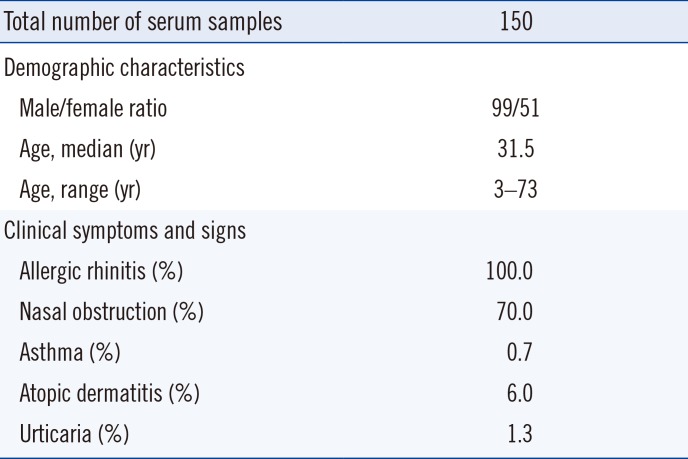
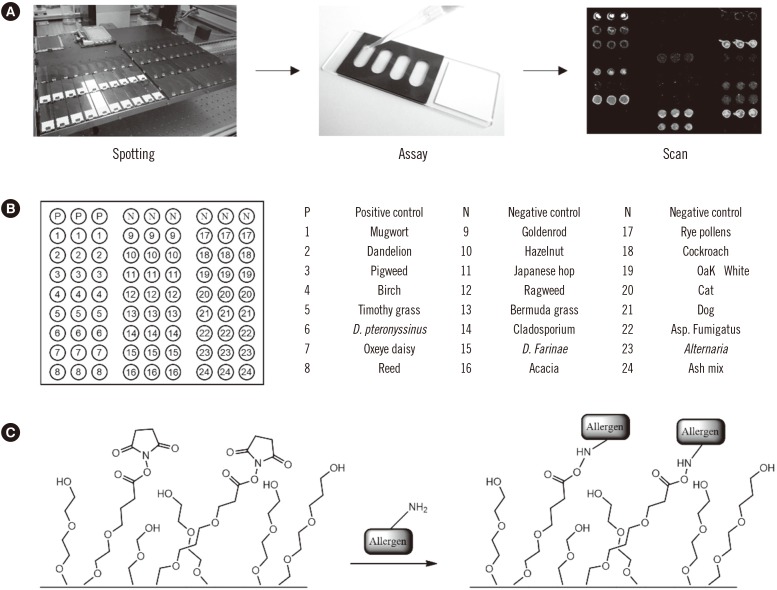
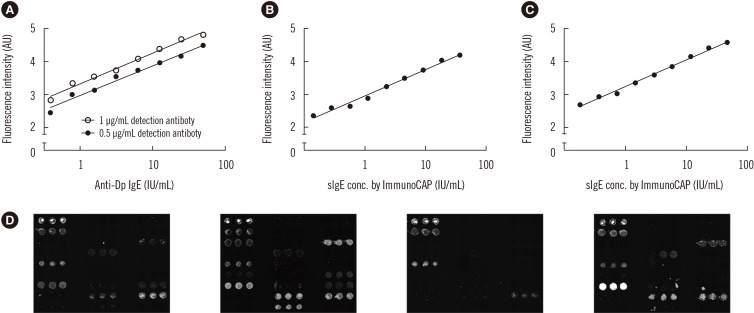

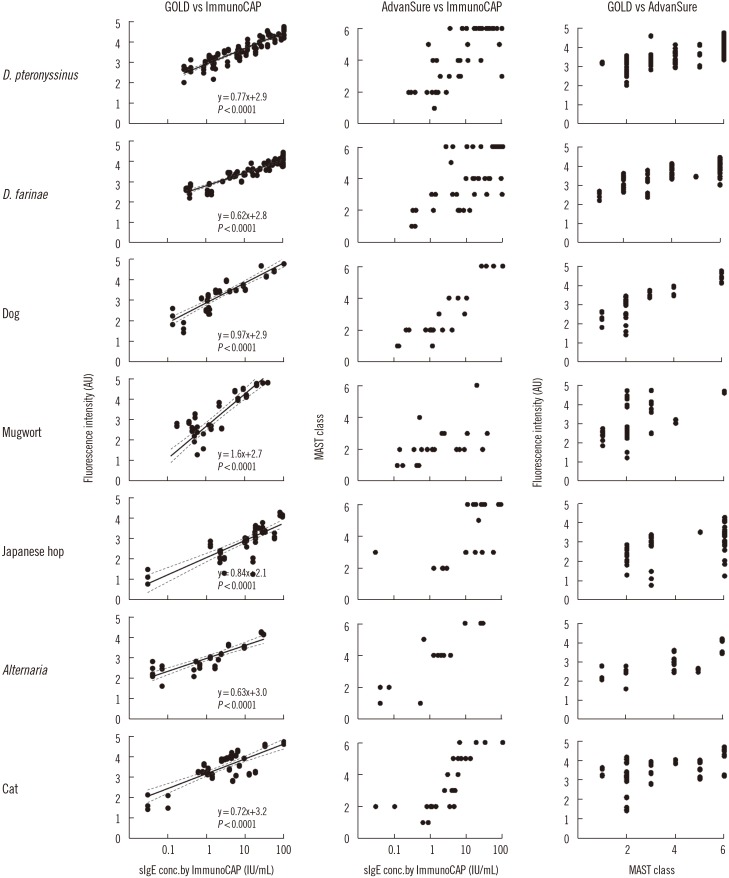
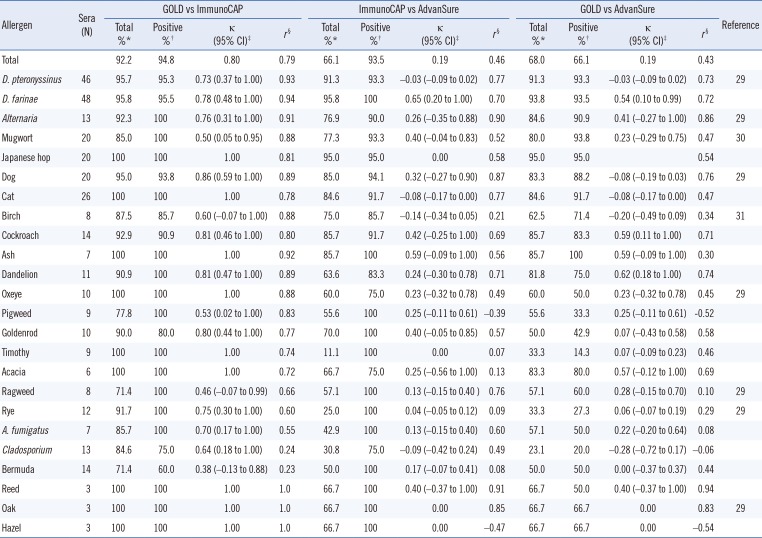




 PDF
PDF ePub
ePub Citation
Citation Print
Print



 XML Download
XML Download